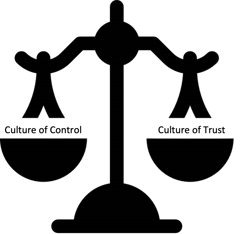Agile transformation takes place between two opposite poles: Strict, easily steerable hierarchy and highly responsive, autonomous teams. Neither one nor the other may be allowed to completely dominate. A constant balancing between both sides is necessary.
Agile methodology is not just "another tool" that is simply bought and installed as a "plug & play" approach, but requires an organizational change if it is to be scaled. What the software factory and its "operating model" ultimately look like and function like develops as part of a systematic approach and process.
In this guide, learn:
Organizational change needs balance. There are two fundamental elements required for the modern organization:

Organization structures must radically change, not dissolve.
Almost all companies are now on the path from a rigid organization to an agile organization. While agile methodology was initially intended more for structuring small teams, this working philosophy has long since been scaled to large software development organizations.
However, in order for developers to be able to work creatively and competently on relevant goals every day, for team leads to constantly maintain an overview, and for top management to be able to influence strategy and efficiency in a targeted manner, a high degree of transparency and directional guidance is also required. Particularly in large IT projects, this can no longer be achieved purely through work organization, but requires support itself through appropriate software and suitable tools. Only in this way can the organization and the people in it keep the steering wheel of software production in their hands.
Every software factory has its gravitational center in one of these elementary categories. Even if corporations were successful in the past as large steamships with a clear and steady strategy, they are increasingly adapting to the rhythm of modern markets. Crucial for success is a clear idea of where one's own organization stands and where it wants to go.

In the rocky waters of modern markets, the corporate tanker is difficult to maneuver. The long-term planning, hierarchically organized, and conservative corporation is generally regarded as vulnerable.

Generally, almost all companies have niches with agile methodology. While the agile teams are able to quickly respond to new demands, they can lack the direction and often transparency available in a more traditional organizational model.

The solution to agile transformation lies in creating a culture of responsibility. Using KPIs and other digital tools, companies can ensure that agile teams are acting in accordance with corporate goals and objectives. Agile teams' performance can be measured, and best practices and knowledge spread.
Without transparency and accountability, it is impossible to align a scaled agile approach with company objectives and strategy. Software production is a highly complex, abstract endeavor that often consists of millions or hundreds of millions lines of code. This makes it by and large unmanageable for most corporations and frustrates efforts to create a coherent software strategy.
Software analytics can solve this problem by creating transparency and accountability where there once was none. The Seerene Digital Boardroom empowers executives and managers with a wide array of KPIs, which allows oversight and strategic alignment. Progress can be tracked and management can intervene where and when needed.
On a more granular level, software analytics further improves efficiency and productivity by highlighting problematic trends and enabling developer teams to drilldown, even to the source code, to quickly and effectively rectify defects and technical debt.
August-Bebel-Str. 26-53
14482 Potsdam, Germany
hello@seerene.com
+49 (0) 331 706 234 0
Generative AI Seerene GmbH
August-Bebel-Str. 26-53
14482 Potsdam, Germany
hello@seerene.com
+49 331 7062340